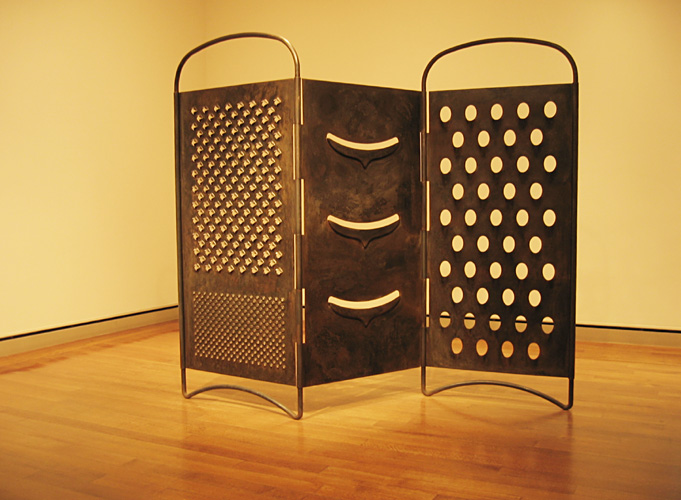Mona Hatoum, born in Lebanon in 1952 from parents of Palestinian origin, left the country in 1975 to spend a study period in London just as war breaks out in Lebanon. She will settle in the British capital and begin her art studies. Far from her native country, the artist has always been sensitive to the issue of identity, both Palestinian and artistic. Her work, multidisciplinary, includes sculpture, video and installation. In her pieces tackles issues such as the vulnerability of individuals in front of the violence relevant to institutional structures, the role of women in the Arab world, or the home, often seen as a prison.
In a world that moves by contradictions, geopolitical tensions and different aesthetics, Mona Hatoum offers us works that reaches a unique universality, a work that has become a “model” for many contemporary artists. The British artist of Palestinian origin is one of the essential representatives of the international contemporary scene. Her work predominates with the relevance of its vision, the adequacy of the forms and materials used, the multiple disciplines involved in her work and eventually her original and committed interpretation of the movements of contemporary art (performance, kinetic art, minimalism).
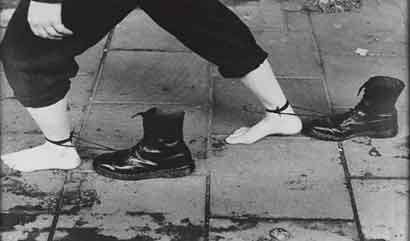 Early in her career Hatoum was an artist of the performance. A form of expression that later fell into disuse, but today has regained new strength, completely renovated. “The performance in the late seventies and early eighties will not look much like today ones. Mine were much improvised, they were not theatrical. It was more a job with the public to provoke their responses”. In 1985 Hatoum produced in the streets of Brixton, a working class neighborhood and predominantly black, located on the outskirts of London two performances during an action organized by fellow artist Stefan Szczelkun entitled “Road Works”, which aims to create a relationship with a very different audience from one that used to visit museums or galleries. In one of these performances Hatoum, barefoot, walking the neighborhood streets with a pair of heavy boots Doc Marten’s tied to the ankles. Her feet appear naked and defenseless against the powerful boots traditionally used by the police or by “skinheads”. The artist presents herself as a marginal person who questions the system, trying to underline her violent structural funcioning, in an action in which the same act of walking becomes difficult.
Early in her career Hatoum was an artist of the performance. A form of expression that later fell into disuse, but today has regained new strength, completely renovated. “The performance in the late seventies and early eighties will not look much like today ones. Mine were much improvised, they were not theatrical. It was more a job with the public to provoke their responses”. In 1985 Hatoum produced in the streets of Brixton, a working class neighborhood and predominantly black, located on the outskirts of London two performances during an action organized by fellow artist Stefan Szczelkun entitled “Road Works”, which aims to create a relationship with a very different audience from one that used to visit museums or galleries. In one of these performances Hatoum, barefoot, walking the neighborhood streets with a pair of heavy boots Doc Marten’s tied to the ankles. Her feet appear naked and defenseless against the powerful boots traditionally used by the police or by “skinheads”. The artist presents herself as a marginal person who questions the system, trying to underline her violent structural funcioning, in an action in which the same act of walking becomes difficult.
In the late eighties Hatoum integrates in her proposals other types of medias such as installations and sculpture. She alsogives a twist toher work,and thoughthe issuesremain the same, are treated in amoreimplicit way, less directlypreferringthe contenttothe formalandaesthetic appearanceof the works.The body of theartistis graduallydisappearing fromher works,togiveimportanceto the presence ofthis other bodythatis theviewer. Hatoumpursuesan emotional responsefrom theviewer, a questioning ofhis environment, of his relationship with the objectsand the world. Therefore,she builds worksdominated byambiguity, in order to achievea greater disparity of interpretations.
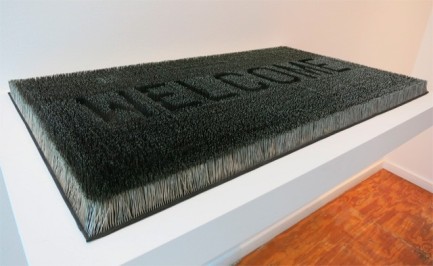 So often, she presents objects that, at first glance or far away, seem attractive but once you get closer you realize that actually cause rejection or are even dangerous. That is what she wants to achieve with “Doormat”. It is a work based on a doormat with the word “Welcome”. In the distance the shiny surface of the carpet looks like velvet, but closer we realize that is made of sharp steel spikes fixed on a frame and pointing upwards. The same applies to “Relaxation”, it is a cradle whose base is made with thin tensioned wires, which means an object which causes feelings of sweetness and tenderness suddenly transformed into an instrument of torture.
So often, she presents objects that, at first glance or far away, seem attractive but once you get closer you realize that actually cause rejection or are even dangerous. That is what she wants to achieve with “Doormat”. It is a work based on a doormat with the word “Welcome”. In the distance the shiny surface of the carpet looks like velvet, but closer we realize that is made of sharp steel spikes fixed on a frame and pointing upwards. The same applies to “Relaxation”, it is a cradle whose base is made with thin tensioned wires, which means an object which causes feelings of sweetness and tenderness suddenly transformed into an instrument of torture.
A remarkable feature since the beginning of her career has been the continuous evolution of her research on the subtle but intense relationship between aesthetics, ethics and politics. Her work stems mainly from everyday life free of conventions about what is private or public and private and institutional.
Hatoum attaches great importance to the materials, manipulates household objects and the human body using different materials: industrial, natural or even immaterial, she chooses them with great precision to develop a concept or contradict the nature of an object. Many times, working with matters of the place where she is. “I’m collecting objects and suddenly things arise, relationships. An atmosphere, a piece,” she says. “I usually visit flea markets and antique stores. They are isolated elements that suddenly, joining them, acquire another sense.
Among her works, the installation of video in 1994 Corps étranger (Foreign Body, 1994) one of the most remarkable. The work was conceived in 1980 but Hatoum could not do it until 1994, when she found the necessary support in the Centre Georges Pompidou in Paris. The project was to explore the inside of her body with a 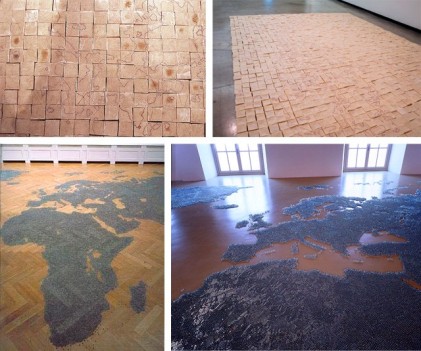 camera. The camera was like a scientific eye that invaded the borders of the body both inside and outside. “Having a camera invading the inside of your body is like to be observed to the center of your being.”
camera. The camera was like a scientific eye that invaded the borders of the body both inside and outside. “Having a camera invading the inside of your body is like to be observed to the center of your being.”
Hatoum frequently used maps in her works. “The first time I used maps was in Jerusalem in 1996. I found a map of the Oslo Agreement between Israel and Palestine, which was signed in 1993. I found it very strange because small areas were drawn as dots without continuity in a territory. It was assumed that was to be the map of a future Palestine. I found it ironic because it was more to divide and to impose rules that allow people to live together. So I drew that map on a set of natural oil olive soaps, with glass beads showing those areas allocated to the Palestinians. I wanted to use soap because it’s a material doesn´t last much, which dissolves “.
Another of the most present topics in the work of the artist is the home. These works generally try to question the idealized notion of home and present an environment that does not look to safe and protective shelter with whom is normally associated that notion. In the installation “Homebound” the artist arranged chairs, crates, cots and metal clothes around a table with various household objects, connected to the current. In both locations there was a wire fence serving a dual role, first to prevent the public come into contact with the current of 240 volts through all the objects of the f installation, but also has a symbolic meaning, become a home jail, expressing 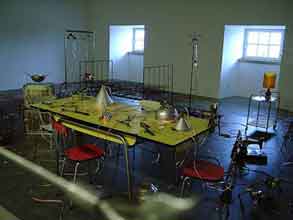 the feelings of women trapped in their homes by the responsibilities and domestic violence, or home as homeland from which one has been exiled and can not re-enter.
the feelings of women trapped in their homes by the responsibilities and domestic violence, or home as homeland from which one has been exiled and can not re-enter.
Humor has always had an important role in her work. “I often associate it with a touch of surrealism to contradict or deflate some of the serious themes of my first works. As Roadworks, a performance of 1985, or in the painting titled “Over My Dead Body” (1988), where the symbol of masculinity was reduced to a toy representing a little soldier. The humor is also evident in sculptures such as “Jardin Public” (1993), “Untitled (wheelchair)” (1998-99), “T42 (gold)” (1999). It is also present in the series of sculptures where enlarge, in surreal proportions, harmless kitchen utensils and turn them into screens or threatening beds. I am interested in Surrealism because I conceive as a visualization of the contradictions and complexities that inhabit us, a way of making art from the intimate reality, rather than from our logical mind. The concept of the stranger, or the family objects which becomes disturbing, or even menacing, because it is associated with trauma, has been present, in one way or another, in my work.”
